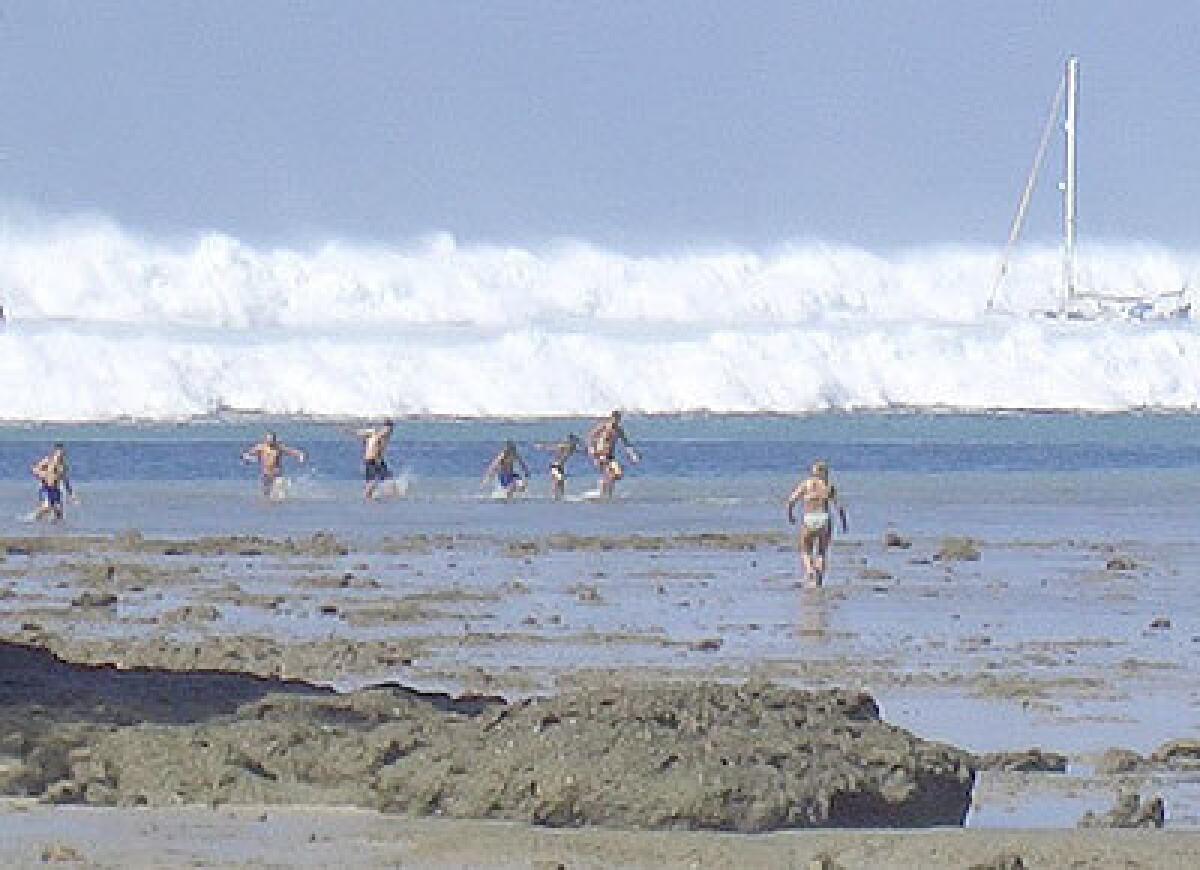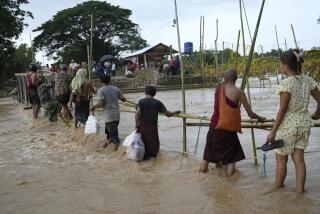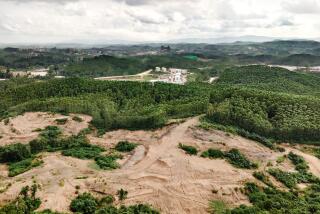Sumatra’s West Coast Devastated

BANDA ACEH, Indonesia — The first survivors from an isolated area of the Sumatran coast were airlifted Thursday to the provincial capital, where they described a horrendous scene in which floodwaters covered a vast swath of land and probably killed more than half of one city’s 100,000 people.
Survivors from the city of Meulaboh arrived with stories of being at sea for days and surviving by hanging naked to the minaret of a mosque. It was another grim detail of one of the worst natural disasters in modern history. The death toll Thursday stood at 125,000 from Sunday’s earthquake and tsunami that struck nations lining the Indian Ocean. At least 80,000 of the dead were from Indonesia.
There was still no clear picture of conditions in some remote villages or on islands off India and Indonesia, raising the specter that the disaster’s toll could yet eclipse the 138,000 killed by a cyclone that struck Bangladesh in 1991.
United Nations Secretary-General Kofi Annan announced that more than 30 countries and organizations had pledged $500 million in aid, half of that from the World Bank.
“I would like to assure the people of the region that the entire United Nations family stands ready to assist, and we stand behind them,” Annan said. “We will work with them in every way we can to rebuild their lives, livelihoods and communities devastated by this catastrophe.”
President Bush, still smarting from charges that the United States was doing too little to assist in relief operations, announced that he was sending Secretary of State Colin L. Powell to the region, along with the president’s brother, Jeb, the governor of Florida.
The United States has pledged $35 million. Britain, France and Sweden have pledged considerably more.
“To coordinate this massive relief effort, firsthand assessments are needed by individuals on the ground,” President Bush said in a written statement delivered at his ranch outside Crawford, Texas. The delegation, he said, would “meet with regional leaders and international organizations to assess what additional aid can be provided by the United States.”
Bush said he was sending his brother because of his experience in recent months dealing with hurricane damage in Florida. White House Deputy Press Secretary Trent Duffy said that sending Gov. Bush underscored the importance of the mission.
“He’s also the president’s brother,” Duffy noted. “I think it signifies the high level of importance that the president puts on this delegation.”
This year the governor won accolades for his attention to recovery efforts after four hurricanes pummeled Florida in a six-week period. Details of the upcoming trip were not immediately available.
In India, Thailand and Sri Lanka, thousands of people fled inland Thursday after unfounded rumors that another tsunami was approaching.
David Nabarro, head of the World Health Organization’s crisis team, said that as many as 5 million people in the region lacked essentials needed to survive.
An estimated 6,000 foreigners, many of them Europeans, were still missing. Swedish Prime Minister Goran Persson said that as many as 1,000 of his countrymen may have died, almost all of them on holiday at the beaches of southern Asia. More than 1,000 others from Scandinavian countries also were listed as missing.
The U.S. death toll was officially raised from 12 to 14, with seven dead in Thailand and seven more in Sri Lanka. State Department spokesman Richard Boucher said an estimated 600 Americans who were listed as missing in the disaster zone had been found. But he said several thousand others had not been located. He said that in Sri Lanka, Americans had been showing up at U.S. consular offices wearing bathing suits, with no money or other clothing.
“Everything else was lost, and we’re taking care of them,” he said. “We’re getting them places to stay, money to buy clothes, new passports, putting them in touch with their relatives.”
The U.S. military sent a team of four forensic anthropologists from Hawaii to the region Thursday to help identify victims, said Army Lt. Col. David Buckingham, the group’s director. The anthropologists normally work on identifying the remains of soldiers found on former battlefields of Vietnam and Korea. They will focus initially on identifying Americans and other foreigners, freeing local forensic experts to work on identifying citizens of their own countries.
The most positive news was that food and medicine were on the way. A U.S. C-130 military transport plane carrying bottled water arrived this morning at the bustling Banda Aceh airport. An Australian military plane, one of five daily flights by the Australians, followed shortly. Boxes of supplies were piled in an open-air warehouse. Helicopters clattered overhead.
The U.S. aircraft carrier Abraham Lincoln and its strike group are now in place off the Indonesian coast, and military officials said that the amphibious Bonhomme Richard Marine Expeditionary Strike Group would reach its destination off the Sri Lankan coast within a week.
It will take longer, officials said, for eight slow-moving Marine cargo ships coming from Guam and the Indian Ocean island of Diego Garcia to reach southeast Asia.
“The tyranny of distance in this region really is amazing,” said Navy Capt. Rodger Welch of the U.S. Pacific Command.
Arjun Katoch, a U.N. senior disaster response official, said Thursday that “the international aid effort is now gathering steam pretty well.”
But that did little to diminish the horror of Meulaboh, which had been cut off since Sunday because bridges from Banda Aceh, about 110 miles to the north, were washed out. One of the survivors evacuated by air, 31-year-old Epayani, said thousands of corpses had been piled up by soldiers. But she said that even with those efforts, the water was turning black from decomposing bodies.
“Meulaboh has become like an ocean,” said Epayani, who like many Indonesians goes by one name. “It is completely destroyed.”
Another group of survivors evacuated by helicopter from Kecamatan Lhoong, 30 miles south of Banda Aceh, said that 24 of 28 villages in the area were destroyed, killing more than 9,000 of the 12,000 people who lived there. The reports from Sumatra’s west coast added to the rapidly increasing death toll in Indonesia.
Mike Griffiths, a New Zealand environmentalist who is active in efforts to preserve northern Sumatra, flew over the island coast and videotaped the destruction. In addition to the damage in Meulaboh, he said, four towns — each with about 10,000 people — were wiped out, except for one where about 30 survivors were camped on a hill.
As the death toll here worsened Thursday, Indonesia accepted an offer from the Australian military to bring in troops and equipment to establish a modern terminal services operation at the Banda Aceh airport to speed up the unloading of aid.
Indonesia also gave the Australian military permission to fly aircraft within Aceh — an unprecedented step in opening the province, which had largely been closed to foreigners during the government’s long-running battle with separatists there.
In Banda Aceh, the army accelerated efforts to pick up corpses from the streets, where thousands of bodies had been left rotting in the tropical heat.
Indonesian President Susilo Bambang Yudhoyono, who visited the area Tuesday, had directed the army to clear the streets of bodies within two days. But there was little chance of meeting the deadline.
Soldiers wearing masks to block the stench used long sticks to push bloated bodies onto plastic sheets, then loaded them onto trucks for burial in mass graves alongside the highway leading to the airport.
Meulaboh is one of the areas closest to the quake’s epicenter. About 100,000 people lived there before the disaster struck.
Military doctors rappelled from helicopters into the city to begin treating the injured. Authorities also are attempting to reopen the airport so that planes can bring in shipments of food, bottled water and medicine.
“It’s impossible to drink the water because it smells of dead bodies,” said Epayani, who was taken by helicopter to Banda Aceh with her badly injured husband and three children.
A few isolated buildings were still standing surrounded by water, she said.
“From what people have seen from the air, it looks like the town of Meulaboh is 90% destroyed,” said Michael Elmquist, head of the U.N. Office for the Coordination of Humanitarian Affairs in Indonesia. “There might not be many survivors. It got the full brunt of the earthquake and [tsunami].”
Epayani, exhausted by her ordeal, recounted a remarkable story of her family’s survival.
Like other witnesses to the tsunami, she described a series of six waves. The first was the largest, about 15 feet high, she said. As it came roaring into the city, she said, all five family members quickly climbed up trees to safety on the roof of their house.
When the second wave hit, her 9-year-old son, Wira, fell off the roof and grabbed a cupboard that was floating by. When the cupboard began sinking, he clambered onto a mattress. The mattress floated away and he quickly became separated from the family. He spent two days drifting in the floodwaters before soldiers rescued him.
The third wave demolished the house. Epayani’s husband, Aliman Hapri, a 38-year-old army sergeant, was washed away and spent the next day floating in the waters. During the ordeal, he was struck in the leg by a piece of wood. He has since developed gangrene and is in danger of losing the limb.
Epayani tried to stay with her other two children, Pardi, 10, and Nora, 9, but they were separated by subsequent waves. Remarkably, the sixth big wave brought the three back together near a mosque, and they were able to cling to its minaret.
The waves had torn off their clothes, and they were naked when soldiers rescued them.
For the next three days, the family lived in appalling conditions, like other survivors. They had nothing to eat and were drinking river water without boiling it because they had no pots or stoves.
“For three days the children were crying, asking for food,” she recalled.
Times staff writers Maggie Farley at the United Nations, Edwin Chen in Crawford, Peter Wallsten in Washington and Richard Fausset in Honolulu contributed to this report.
More to Read
Sign up for Essential California
The most important California stories and recommendations in your inbox every morning.
You may occasionally receive promotional content from the Los Angeles Times.










